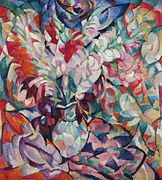
Leo Gestel (11 November 1881, Woerden – 26 November 1941, Hilversum) was a Dutch painter. His father Willem Gestel was also an artist. Leo Gestel experimented with cubism, expressionism, futurism and postimpressionism. Along with Piet Mondrian and Jan Sluyters he was among the leading artists of Dutch modernism.
Life
[edit]
Gestel was first instructed in art by his father, Willem Gestel, the director of an art school, and his uncle, Dimmen Gestel, who had painted with Vincent van Gogh. Due to financial problems Gestel created advertisements (e.g. for Philips) for illustrated books.
While in Paris he came in contact with the avant-garde movement. In 1913 Herwarth Walden offered him the chance to exhibit work in the "Erster Deutscher Herbstsalon" in Berlin. Generally Gestel spent the summer in Bergen, where he joined the Bergen School. In 1929 the majority of his works were lost when a fire destroyed his studio; he then moved to Blaricum.
Public collections
[edit]- Stedelijk Museum Alkmaar, Alkmaar
- Drents Museum, Assen
- Museum De Hallen, Haarlem
- Frans Hals Museum, Haarlem
- Singer Laren, Laren
- Kröller-Müller museum, Otterlo
- Museum van Bommel van Dam, Venlo
- Museum de Fundatie in Zwolle
- Leo Gestel's works
-
Mallorca, Terreno
-
Blue tree
-
Nude
-
Idle moments
-
Boats along the shore 1908
-
Flowers, 1913
-
Portrait of Else Berg, 1913
References
[edit]- Trappeniers, Maureen S. "Gestel, Leo." In Grove Art Online. Oxford Art Online, (accessed February 3, 2012; subscription required).
- Leo gestel in the RKD
External links
[edit]- Entry for Leo Gestel on the Union List of Artist Names
- More information on artfacts.net.
- Leo Gestel on ArtCyclopedia








Well, that’s interesting to know that Psilotum nudum are known as whisk ferns. Psilotum nudum is the commoner species of the two. While the P. flaccidum is a rare species and is found in the tropical islands. Both the species are usually epiphytic in habit and grow upon tree ferns. These species may also be terrestrial and grow in humus or in the crevices of the rocks.
View the detailed Guide of Psilotum nudum: Detailed Study Of Psilotum Nudum (Whisk Fern), Classification, Anatomy, Reproduction